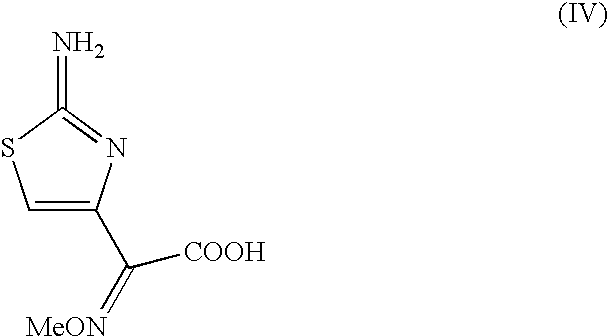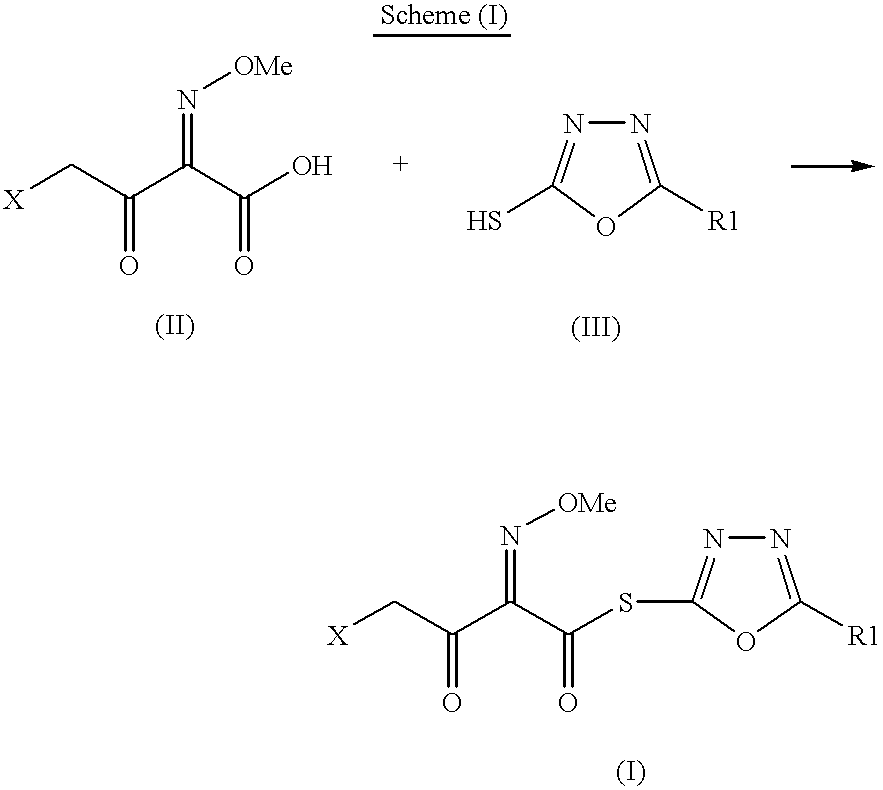Preparation of new intermediates and their use in manufacturing of cephalosporin compounds
a technology of cephalosporin and new intermediates, which is applied in the field of new reactive thioester derivatives, can solve the problems of complex procedures, low yield, and limited poor yield by moderate yield, and achieve good purity and yield, and excellent yield
- Summary
- Abstract
- Description
- Claims
- Application Information
AI Technical Summary
Benefits of technology
Problems solved by technology
Method used
Image
Examples
example 1
Synthesis of 2-mercapto-5-phenyl-1,3,4-oxadiazolyl-(Z)-4-bromo-2-methoxyimino-3-oxo-butyrate (I).
Phosphorus oxy chloride (25.6 g) was added slowly to N,N-dimethyl formamide (12.2 g) at 0 to -5.degree. C. Stirred for 30 minutes. Acetonitrile (200 ml) was added followed by 4-bromo-2-methoxyimino-3-oxo-butyric acid (25.0 g) and 5-phenyl-1,3,4-oxadiazole-2-thiol (19.8 g). Pyridine (44.1 ml) was slowly added to the flask at -10.degree. C. The progress of the reaction was monitored by HPLC. After the disappearance of the starting material, the reaction mass was poured into ice-water, white colored solid separated out which was filtered and washed with water. Dried under vacuum to obtain 40.8 gm of thioester with HPLC purity (96.0-98.0%).
Melting point: 139-140.degree. C.
.sup.1 HNMR (DMSO-d.sub.6): .delta.4.1 (3H,s,N--OCH.sub.3), 4.3(2H,s,BrCH.sub.2 CO) 7.6-7.9(5H, m, --C.sub.6 H.sub.5)
.sup.13 C-NMR(CDCl.sub.3): .delta.30.2, 65.8, 121.3, 127.7, 129.7, 134.1, 147.5, 147.8, 156.3, 160.2, 186....
example 2
3-Acetyloxymethyl-7-[(Z)-(2-aminothiazolyl-4-yl)-2-(methoxyimino)acetamido]-3-cephem-4-carboxylic acid (Cefotaxime acid).
Method -I
A mixture of THF (250 ml) and water (150 ml) and N,N-dimethylacetamide (25.0 ml) was stirred under inert atmosphere. At 0.degree.-5.degree. C., 7-aminocephalosporanic acid (25.0 g) and 2-mercapto-5-phenyl-1,3,4-oxadiazolyl-(Z)-4-bromo-2-methoxyimino-3-oxo-butyrate (46.0 g) were added. Triethylamine (20.4 g) was slowly added to reaction by maintaining pH 7.0 to 8.0. The reaction was checked by HPLC. After 6-8 hrs., the reaction mixture was extracted by methylene chloride(200.times.3). The aqueous layer is subjected for charcoal treatment. Thiourea (18.4 g) and sodium acetate (4.2 g) were added to the filtered aqueous layer and stirred for 1.0 hr to get the cefotaxime which was isolated with subsequent acidification of the aqueous layer with dil. HCl at 10.degree. C. to pH 3.0. The solid separated was filtered, washed with water and ethylacetate and then dr...
example 3
7-[[(Z)-2-(2-Aminothiazol-4-yl)2-methoxyimino]acetamido]-3-[[(2,5-dihydro-6-hydroxy-2-methyl-5-oxo-1,2,4-triazin-3 -yl)thio]methyl]-3-cephem-4-carboxylic acid disodium hemiheptahydrate (Ceftriaxone sodium).
Method -I
7-Amino-3-[[(2,5-dihydro-6-hydroxy-2-methyl-5-oxo-1,2,4-triazin-3yl)thio]methyl]3-cephem-4-carboxylic acid (20.0 g) and 2-mercapto-5-phenyl-1,3,.sup.4 -oxadiazolyl-(Z)-4-bromo-2-methoxyimino-3-oxo-butyrate (27.2 g) were suspended in a mixture of THF (180 ml), H.sub.2 O (80 ml) and DMAc (30 ml) maintained at 0-1.degree. C. under stirring. Triethylamine (11.9 ml) was added in 2-3 hours at 5.degree. C. maintaining the pH 7.5-8.5. The reaction progress was monitored by HPLC. After the reaction was completed, the mixture was extracted with dichloromethane (3.times.100 ml). The aq. layer was separated and treated with charcoal (0.2 g). Thiourea (10.9 g) is added to the solution and stirred for 1.0 hr. till cyclisation is over. A solution of sodium-2-ethylhexanoate (30.5 g) in a...
PUM
 Login to View More
Login to View More Abstract
Description
Claims
Application Information
 Login to View More
Login to View More - R&D
- Intellectual Property
- Life Sciences
- Materials
- Tech Scout
- Unparalleled Data Quality
- Higher Quality Content
- 60% Fewer Hallucinations
Browse by: Latest US Patents, China's latest patents, Technical Efficacy Thesaurus, Application Domain, Technology Topic, Popular Technical Reports.
© 2025 PatSnap. All rights reserved.Legal|Privacy policy|Modern Slavery Act Transparency Statement|Sitemap|About US| Contact US: help@patsnap.com



